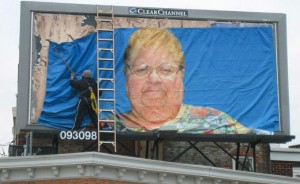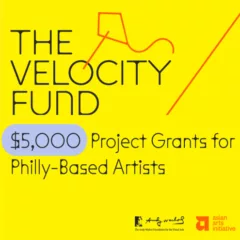“What the hell?” sums up Zoe Strauss’s rationale for choosing one of three paintings from the archives of the Philadelphia Museum of Art to hang in her temporary office at the museum. This could easily also be the reaction of unsuspecting passers by to one of Strauss’s billboard photos. Countless people must by now have stumbled on the citywide series of billboard prints while dozing off on SEPTA, crossing Gray’s Ferry Ave., or looking up from their iPhones. As the familiar city landscape reveals a less familiar face or empty storefront pictured where an advertisement once was, viewers have been intrigued, delighted, and even challenged to make sense of the phenomenon. It’s all part of Strauss’s show Zoe Strauss: 10 Years Retrospective, an exhibit that extends from inside the PMA to the streets of the city.
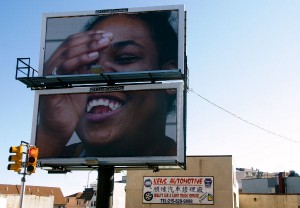
Rewind 10 years: Zoe Strauss is given a Canon Rebel, the tool to finally start creating the beast of an installation she has been envisioning for years. Hoping to transform the space under I-95—which has itself transformed Strauss’s South Philly neighborhood—and to capture the changes over time that this community has undergone, Strauss set up ten annual exhibitions under the highway, with prints for sale of the many Philadelphians she’s taken portraits of, and prints of the many places in the city and elsewhere she has found inspiration.
Fast forward to January 14th, 2012: Questlove is performing at the 10 Years opening to a crowd that can’t quite believe they’re at a PMA reception. Waiting in line to get your photos taken at the party booth, you only wish your prom had been this cool, complete with fabulous Conestoga Angels drum line performances.
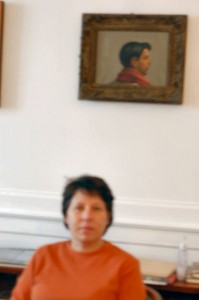
Fast forward about ten days: I’m sitting on the floor with Strauss during her office hours eating chips and asking about the three paintings around us. Back to that “what the hell” portrait behind Strauss of a young man with dark hair and a wine colored scarf who glances backwards at the viewer. She forgets on the spot who it’s by and admits she doesn’t even necessarily like the painting that much. She simply embraced the chance to keep looking at it in her office and perhaps figure out its intrigue. This small painting exudes a mystery that I pick up from Strauss’s more abstract work, in addition to her shots of empty storefronts and faded signage and graffiti. Trying to understand any messages behind these images, I ask Strauss if they’re piecing together a mixed-up urban poetry to match the social landscape she’s imagined for us. She tells me the messages are “open and available for repurposing.” Just as Strauss converted expanses under I-95—not unlike the FDR skate park and Boat People guerrilla farmers’ markets continue to do in similar expanses—she’s moved on to repurpose commercial billboard space. These works on the billboards tell “an epic narrative about the beauty and struggle of everyday life”—Strauss’s words.
While the billboards evoke the Love Letter series of murals by Steve Powers, which Strauss was a champion and documentarian of, the billboards’ likely fate in a few months is to turn into a new string of tasteless ads for Delilah’s. Their inevitable evolution mimics the mutability—intrinsic to Strauss’s work—of signifiers, community, and individuals. One empowering adoption of a mutable image, “We Will Win,” represents a very specific and deeply personal sentiment of AIDS advocates over the past 30 years. Strauss confirmed that the repurposing of her visual message in the Witness exhibition that long-time friend David Acosta did at the Asian Arts Initiative perfectly represents her willingness to let her photos’ messages reincarnate many times over. Not enough can be written about the impact of Strauss’s work, which resonates with Philadelphians today, but which has the power to reach communities other artists and institutions can’t and won’t.
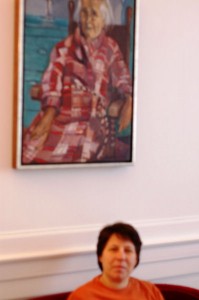
Turn around: The Alice Neel painting behind me features the face of the elderly woman in a patchwork bathrobe which must read differently by everyone from the public who has visited Strauss in her office (PMA Director Timothy Rub’s satellite office, which he gave to Strauss for the duration of her exhibition). She takes a moment as we’re talking to admire the complexity of emotions expressed by the woman in “Last Sickness,” which, not unlike her work, is up to the viewer’s interpretation, subject to multiple reads, and void of pedantic descriptions.
Cello music sounds faintly down the hall, and I ask Strauss about the fate of the Megawords room where I waited before entering her office, and where Philadelphia Orchestra’s Hai-Ye Ni, propping her cello against plush pillows on the ground, is practicing for the afternoon show.
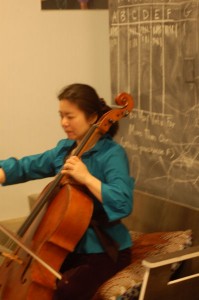
The Megawords installation runs kitty-corner to her retrospective, and like the artist’s office hours, serves as a new programming model for the PMA. Visitors from 10 Years and Van Gogh mill in and out of the installation wondering “what the hell” happened to the “scary,” old ATM/phone booth dug-outs. Megawords, “an experimental media project,” raises eyebrows with an explosion of photos, zines, chalkboard, and publications for sale in the tiny alcoves. Megawords also seeks to document the “ongoing narrative” of urban life with their installations and concurrent events.
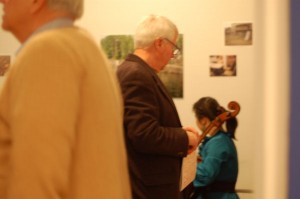
Fast forward ten more years? Strauss makes no predictions for what will become of the new spaces—possibly now with chip crumbs in the carpets!—created for her exhibition inside the PMA and all over the city. My hope is that this wonderful experiment (please, include more dance parties!) produces many more experiments in its wake. Philly deserves thought-provoking and purely awesome “what the hell” moments for many more than ten years to come.


